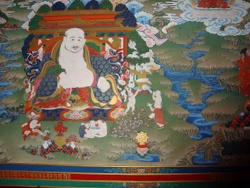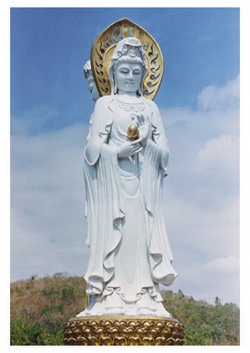Difference between revisions of "Fazang and Daoxuan"
m (Text replacement - "ten" to "ten") |
|||
| (5 intermediate revisions by 4 users not shown) | |||
| Line 1: | Line 1: | ||
[[File:Fazang.Portrait.jpg|thumb|250px|]] | [[File:Fazang.Portrait.jpg|thumb|250px|]] | ||
| + | |||
| + | |||
| + | |||
| + | |||
| + | |||
| + | |||
| + | |||
| + | |||
<poem> | <poem> | ||
| − | There is no [[doubt]] that [[Fazang]] was reading the [[Vinaya]] [[master]] [[Daoxuan']]s [[道宣]] (596-667) work and incorporating some of [[Daoxuan's]] [[ideas]] into his own treatises. This is clear because [[Fazang]] borrows [[Daoxuan's]] {{Wiki|dichotomy}} of edifying teachings or [[huàjiào]] [[化教]] and practical teachings [[xíngjiào]] [[行教]]. [[Fazang]] calls the latter disciplinary teachings or [[zhìjiào]] [[制教]]. We should first examine [[Daoxuan's]] own definition of the two terms: | + | There is no [[doubt]] that [[Fazang]] was reading the [[Vinaya]] [[master]] [[Daoxuan']]s [[道宣]] (596-667) work and incorporating some of [[Daoxuan's]] [[ideas]] into his [[own]] treatises. This is clear because [[Fazang]] borrows [[Daoxuan's]] {{Wiki|dichotomy}} of edifying teachings or [[huàjiào]] [[化教]] and {{Wiki|practical}} teachings [[xíngjiào]] [[行教]]. [[Fazang]] calls the [[latter]] disciplinary teachings or [[zhìjiào]] [[制教]]. We should first examine [[Daoxuan's]] [[own]] [[definition]] of the two terms: |
《四分律刪繁補闕行事鈔》卷1: 「顯理之教乃有多途。而可以情求大分為二。一謂化教。此則通於道俗。但汎明因果識達邪正。科其行業沈密而難知。顯其來報明了而易述。二謂行教。唯局於內眾 定其取捨立其網致。顯於持犯決於疑滯。指事曲宣文無重覽之義。結罪明斷事有再科之愆。然則二教循環非無相濫。舉宗以判理自彰矣。謂內心違順託理為宗則準化 教。外用施為必護身口便依行教。然犯化教者但受業道一報。違行教者重增聖制之罪。故經云。受戒者罪重不受者罪輕。文廣自明所以更分者。恐迷二教之宗體妄述 業行之是非。故立一門永用蠲別。」(1) | 《四分律刪繁補闕行事鈔》卷1: 「顯理之教乃有多途。而可以情求大分為二。一謂化教。此則通於道俗。但汎明因果識達邪正。科其行業沈密而難知。顯其來報明了而易述。二謂行教。唯局於內眾 定其取捨立其網致。顯於持犯決於疑滯。指事曲宣文無重覽之義。結罪明斷事有再科之愆。然則二教循環非無相濫。舉宗以判理自彰矣。謂內心違順託理為宗則準化 教。外用施為必護身口便依行教。然犯化教者但受業道一報。違行教者重增聖制之罪。故經云。受戒者罪重不受者罪輕。文廣自明所以更分者。恐迷二教之宗體妄述 業行之是非。故立一門永用蠲別。」(1) | ||
| − | The [[teaching]] which reveals the [[truth]] has many avenues, but one can ascertain a large division of two. The first is called the edifying teachings. This would encompass both the {{Wiki|holy}} and vulgar. It just broadly illuminates [[cause and effect]]. [[Consciousness]] reaches right and wrong | + | The [[teaching]] which reveals the [[truth]] has many avenues, but one can ascertain a [[large division]] of two. The first is called the edifying teachings. This would encompass both the {{Wiki|holy}} and [[vulgar]]. It just broadly illuminates [[cause and effect]]. [[Consciousness]] reaches right and wrong ([[morality]]). Analyzing [[karma]] is {{Wiki|subtle}} and difficult to know. Revealing those {{Wiki|future}} repercussions is to be understood and easily explained. The second is called {{Wiki|practical}} teachings, which are just |
| + | |||
| + | limited to the inner assembly, setting what is adopted and rejected and establishing control. It is revealed by the maintenance and {{Wiki|violation}} [of the [[precepts]]), decided by [[doubt]] and obstruction. All [[precepts]] are individually indicated and explained in detail. The text need not be doubly read. One binds the [[sin]] and clearly severs it. Each [[precept]] [if violated] has the offence of multiple {{Wiki|transgression}} [because one violates the [[monastic]] [[precept]] and commits negative [[karma]]). | ||
| + | |||
| + | Thus the two teachings rotate around each other and are not without mutual interflow. In examining the model and making {{Wiki|distinctions}}, the {{Wiki|principle}} indeed reveals itself. | ||
| + | |||
| + | It is said that internally the [[mind]] has adversity and [[favourable]] circumstances -- relying on the {{Wiki|principle}} as the model one then learns the edifying [[teaching]]. Externally [[actions]] are undertaken – one must {{Wiki|guard}} the [[body]] and [[speech]] and so then one depends on the {{Wiki|practical}} [[teaching]]. Thus, one who violates the edifying teachings only receives a single retribution on the [[path]] of [[karma]]. The one who violates the {{Wiki|practical}} teachings doubly {{Wiki|increases}} the [[sin]] of [violating] the [[sacred]] [[discipline]]. | ||
| − | |||
| − | + | Thus, the [[scripture]] says, “For those who have received the [[precepts]] it is heavy [[sin]]. For those who have not received it is minor [[sin]].” The texts are broad and clear in themselves, so further [[analysis]] I {{Wiki|fear}} would lead to {{Wiki|confusion}} of the [[essence]] of the two teachings or to deluded explanations of the rights and wrongs of [[karma]]. Thus we establish one method and forever utilize a clear {{Wiki|distinction}}. | |
| − | Thus, the [[scripture]] says, “For those who have received the [[precepts]] it is heavy [[sin]]. For those who have not received it is minor [[sin]].” The texts are broad and clear in themselves, so further [[analysis]] I {{Wiki|fear}} would lead to {{Wiki|confusion}} of the [[essence]] of the two teachings or to deluded explanations of the rights and wrongs of [[karma]]. Thus we establish one method and forever utilize a clear distinction. | + | [[Fazang]] repeats [[Daoxuan's]] [[ideas]] in the same [[order]] indicating he was reading [[Daoxuan's]] work and recycling it for his [[own]] use: |
| − | [[Fazang]] repeats [[Daoxuan's]] [[ideas]] in the same [[order]] indicating he was reading Daoxuan's work and recycling it for his own use: | ||
《梵網經菩薩戒本疏》卷1: 「第三攝教分齊者。聖教塵沙。緣略為二。一是化教。二是制教。釋此二別略作四門。一約法異。且化教者。謂如來出世。普為一切說諸因果理事等法。制教者。謂 舉過顯非。立正法制非理。違法犯結示罪名。辨其持犯輕重篇聚。二約機異。謂化教普為通內外眾。莫問佛法內人及佛教外人。通對而說。制教唯對佛自內眾私祕制 說。三約益異。謂化教但令離諸性惡起信等行。制教令其雙離遮性。以護譏嫌威儀可軌。以生物信光顯正法自行化人故。四約主異。謂化教通於五種人說。如智論 云。一佛。二菩薩。三弟子。四神仙。五變化。制教唯佛自說。以制戒輕重餘無能故。由此四異。是故二教成差別也。於此二中制教所攝。然制通大小。仍是大 收。」(2) | 《梵網經菩薩戒本疏》卷1: 「第三攝教分齊者。聖教塵沙。緣略為二。一是化教。二是制教。釋此二別略作四門。一約法異。且化教者。謂如來出世。普為一切說諸因果理事等法。制教者。謂 舉過顯非。立正法制非理。違法犯結示罪名。辨其持犯輕重篇聚。二約機異。謂化教普為通內外眾。莫問佛法內人及佛教外人。通對而說。制教唯對佛自內眾私祕制 說。三約益異。謂化教但令離諸性惡起信等行。制教令其雙離遮性。以護譏嫌威儀可軌。以生物信光顯正法自行化人故。四約主異。謂化教通於五種人說。如智論 云。一佛。二菩薩。三弟子。四神仙。五變化。制教唯佛自說。以制戒輕重餘無能故。由此四異。是故二教成差別也。於此二中制教所攝。然制通大小。仍是大 收。」(2) | ||
[[File:DSC05268.JPG|thumb|250px|]] | [[File:DSC05268.JPG|thumb|250px|]] | ||
| + | |||
| + | |||
III. Differences of the Incorporated Teachings | III. Differences of the Incorporated Teachings | ||
| Line 21: | Line 35: | ||
1. Concerning the differences in [[Dharma]] or provisionally the edifying teachings. | 1. Concerning the differences in [[Dharma]] or provisionally the edifying teachings. | ||
| − | These are said to be the teachings of [[cause and effect]], {{Wiki|principle}} and [[phenomena]], and so on which the [[Tathāgata]] universally taught for all [[beings]] when he appeared in the [[world]]. | + | These are said to be the teachings of [[cause and effect]], {{Wiki|principle}} and [[phenomena]], and so on which the [[Tathāgata]] universally [[taught]] for all [[beings]] when he appeared in the [[world]]. |
| − | The disciplinary teachings are said to be where he discussed transgressions and elucidated errors. He established the proper [[Dharma]] and restricted improper [behaviors]. Violations are collectively designated as [[sin]]. He discussed the maintenance, violation and the two classifications of minor and major [[precepts]]. | + | The disciplinary teachings are said to be where he discussed transgressions and elucidated errors. He established the proper [[Dharma]] and restricted improper [behaviors]. Violations are collectively designated as [[sin]]. He discussed the maintenance, {{Wiki|violation}} and the two classifications of minor and major [[precepts]]. |
2. Concerning the differences in {{Wiki|individual}} {{Wiki|abilities}}. | 2. Concerning the differences in {{Wiki|individual}} {{Wiki|abilities}}. | ||
| − | This is said to be that the edifying teachings universally pass through the inner and outer masses. There is no question of those within the [[Buddhadharma]] and those outside the [[Buddhadharma]]. They are explained to all. The disciplinary teachings are only taught in private to the [[Buddha's]] own inner assembly. | + | |
| + | |||
| + | This is said to be that the edifying teachings universally pass through the inner and outer masses. There is no question of those within the [[Buddhadharma]] and those outside the [[Buddhadharma]]. They are explained to all. The disciplinary teachings are only [[taught]] in private to the [[Buddha's]] [[own]] inner assembly. | ||
3. Concerning differences in {{Wiki|benefit}}. | 3. Concerning differences in {{Wiki|benefit}}. | ||
| − | This is said to be that the edifying teachings only foster the practices of raising [the ten] śraddhās free from [the {{Wiki|obstacles}} of] inherently {{Wiki|immoral}} acts [such as killing, [[stealing]] and so on] . The disciplinary teachings foster [practices] free from both the inherently {{Wiki|immoral}} acts and [[activities]] which disturb one's training [such as tilling the soil or building domiciles]. | + | This is said to be that the edifying teachings only foster the practices of raising [the ten] śraddhās free from [the {{Wiki|obstacles}} of] inherently {{Wiki|immoral}} acts [such as {{Wiki|killing}}, [[stealing]] and so on] . The disciplinary teachings foster [practices] free from both the inherently {{Wiki|immoral}} acts and [[activities]] which disturb one's {{Wiki|training}} [such as tilling the soil or building domiciles]. |
| + | |||
| + | Deportment should be followed so to {{Wiki|guard}} against [[slander]] as the [[light]] of [[beings]]' conviction illuminates the true [[Dharma]] and one practises [[teaching]] [[people]]. | ||
| − | |||
4. Concerning [[primary]] differences. | 4. Concerning [[primary]] differences. | ||
| + | |||
| + | |||
[[File:Fj3.jpg|thumb|250px|]] | [[File:Fj3.jpg|thumb|250px|]] | ||
| − | This is said to be that the edifying teachings are taught through the five types of persons. The [[Mahāprajñāpāramitā-śāstra]] states, “First is [[Buddha]]. Second is [[bodhisattva]]. Third is [[disciple]]. Fourth is the immortals. Fifth is apparitional beings.”(3) | + | This is said to be that the edifying teachings are [[taught]] through the five types of persons. The [[Mahāprajñāpāramitā-śāstra]] states, “First is [[Buddha]]. Second is [[bodhisattva]]. Third is [[disciple]]. Fourth is the [[immortals]]. Fifth is [[apparitional]] beings.”(3) |
The disciplinary teachings are only the [[Buddha's teaching]] as there is no [[power]] [[beyond]] the minor and major disciplinary [[precepts]]. | The disciplinary teachings are only the [[Buddha's teaching]] as there is no [[power]] [[beyond]] the minor and major disciplinary [[precepts]]. | ||
| − | It is thus from these four differences [as outlined above 1-4] that the two teachings are distinguished. Within these two [teachings] the disciplinary teachings are included and thus the disciplinary [teachings] pass through the great and small | + | It is thus from these four differences [as outlined above 1-4] that the two teachings are {{Wiki|distinguished}}. Within these two [teachings] the disciplinary teachings are included and thus the disciplinary [teachings] pass through the great and small ([[Mahāyāna]] and [[Hīnayāna]]). Consequently this is a [[great collection]]. |
| − | It is clear that [[Fazang]] has adopted [[Daoxuan's]] [[ideas]] of a {{Wiki|dichotomy}} between edifying teachings and practical or disciplinary teachings and then proceeded to present his predecessor's [[ideas]] on paper in the same [[order]]. [[Fazang]] elaborates on [[Daoxuan's]] [[ideas]] in his usual way of creating numbered lists and detailing each one individually. | + | It is clear that [[Fazang]] has adopted [[Daoxuan's]] [[ideas]] of a {{Wiki|dichotomy}} between edifying teachings and {{Wiki|practical}} or disciplinary teachings and then proceeded to {{Wiki|present}} his predecessor's [[ideas]] on paper in the same [[order]]. [[Fazang]] elaborates on [[Daoxuan's]] [[ideas]] in his usual way of creating numbered lists and detailing each one individually. |
| − | One [[interesting]] thing to note here is that [[Fazang]] has adopted for his own purposes these terms from Daoxuan, but applied them to a text [[Daoxuan]] only referenced once in his extensive commentary on the [[Vinaya]].(4) [[Daoxuan]] seldom made reference to the [[Fànwăng-jīng]]. [[Fazang]] in a text likely composed around the same [[time]] – his commentary on the [[Huáyán-jīng]] – also employed the same borrowed terms.(5) | + | One [[interesting]] thing to note here is that [[Fazang]] has adopted for his [[own]] purposes these terms from [[Daoxuan]], but applied them to a text [[Daoxuan]] only referenced once in his extensive commentary on the [[Vinaya]].(4) [[Daoxuan]] seldom made reference to the [[Fànwăng-jīng]]. [[Fazang]] in a text likely composed around the same [[time]] – his commentary on the [[Huáyán-jīng]] – also employed the same borrowed terms.(5) |
| + | |||
| + | One final [[idea]] {{Wiki|present}} in [[Fazang's]] work which appears again to have some [[influence]] from [[Daoxuan]], though he cites a [[sūtra]] in this case, is the notion that [[śrāvaka]] [[precepts]] fail to {{Wiki|guard}} against [[mental]] [[evils]] or refute [[views]]. | ||
| − | |||
《梵網經菩薩戒本疏》卷1:「聲聞小戒不防意惡不破諸見。不名真梵。諸菩薩等所持三聚具防三業破見入理。方名實梵。此如華嚴梵行品說。」(6) | 《梵網經菩薩戒本疏》卷1:「聲聞小戒不防意惡不破諸見。不名真梵。諸菩薩等所持三聚具防三業破見入理。方名實梵。此如華嚴梵行品說。」(6) | ||
| − | The [[lesser]] [[precepts]] of the [[śrāvaka]] do not {{Wiki|guard}} against {{Wiki|conceptual}} [[evil]] and do not destroy [wrong] [[views]]. They are not called true [[brahma-caryā]]. The three sets [of [[pure]] [[precepts]] | + | The [[lesser]] [[precepts]] of the [[śrāvaka]] do not {{Wiki|guard}} against {{Wiki|conceptual}} [[evil]] and do not destroy [wrong] [[views]]. They are not called true [[brahma-caryā]]. The three sets [of [[pure]] [[precepts]]) which the [[bodhisattvas]] observe thoroughly {{Wiki|guard}} the three [[karmas]] [of [[body]], [[speech]] and [[mind]]), destroy [[views]] and they then ascertain the {{Wiki|principle}}. This then is called true [[brahma-caryā]]). This is like how the [[brahma-caryā]] [[chapter]] in the [[Huáyán]] ([[sūtra]]) explains it. |
[[File:FS KwanKung 60116.jpg|thumb|250px|]] | [[File:FS KwanKung 60116.jpg|thumb|250px|]] | ||
Regardless of [[Fazang's]] allusion here to an article in [[sūtra]] which interestingly does not express the sentiments he himself is expressing, judging from [[Fazang's]] evident reading of [[Daoxuan's]] work, it seems reasonable to conclude that he did indeed draw these [[ideas]] from [[Daoxuan]] who proposes that [[pratyekabuddha]] and [[śrāvaka]] [[precept]] systems are limited to [[verbal]] and [[physical]] [[activities]]: | Regardless of [[Fazang's]] allusion here to an article in [[sūtra]] which interestingly does not express the sentiments he himself is expressing, judging from [[Fazang's]] evident reading of [[Daoxuan's]] work, it seems reasonable to conclude that he did indeed draw these [[ideas]] from [[Daoxuan]] who proposes that [[pratyekabuddha]] and [[śrāvaka]] [[precept]] systems are limited to [[verbal]] and [[physical]] [[activities]]: | ||
| Line 57: | Line 77: | ||
《四分律刪繁補闕行事鈔》卷3:「若據二乘戒緣身口。犯則問心。執則障道。是世善法。違則障道。不免三塗。定約名色。緣修生滅為理。二乘同觀。亦無諦緣之別。」(7) | 《四分律刪繁補闕行事鈔》卷3:「若據二乘戒緣身口。犯則問心。執則障道。是世善法。違則障道。不免三塗。定約名色。緣修生滅為理。二乘同觀。亦無諦緣之別。」(7) | ||
| − | If we rely on the two vehicles | + | If we rely on the [[two vehicles]] ([[pratyekabuddha]] and [[śrāvaka]]), the [[precepts]] follow [[body]] and [[speech]]. In {{Wiki|violation}} one questions the [[mind]]. Excessive [[attachment]] hinders the [[path]]. These good [[dharmas]] of the [[world]] if opposed will hinder the [[path]] and one is not exempt from the three hellish destinies. Their [[samādhi]] deals with [[nāma-rūpa]]. [[Meditative]] {{Wiki|examination}} of [[conditionality]] [of the [[aggregates]]) and their [[rising]] and [[cessation]] is the {{Wiki|principle}} [of their [[samādhi]] {{Wiki|training}}]. The [[two vehicles]] have the same [[view]]. There are also no {{Wiki|distinct}} [trainings] [[beyond]] the [[four noble truths]] and the [[twelve links]] of dependent origination.(8) |
| − | [[Daoxuan]] is alluding to the [[idea]] that [[pratyekabuddha]] and [[śrāvaka]] practices are limited to the [[cessation]] of cyclic [[existence]] and that they lack the {{Wiki|superior}} [[comprehension]] of things only available to the [[bodhisattva]]. The latter remark seems to mean that while nominally the [[śrāvakas]] chiefly utilize the [[four noble truths]] and the [[pratyekabuddhas]] primarily [[contemplate]] the [[twelve links of dependent origination]], the [[essential]] [[view]] of [[cessation]] between the two is identical though their methods differ. Daoxuan then carries on his [[discussion]] to outline the [[essential]] quality of the [[Mahāyāna]] [[precepts]]. | + | [[Daoxuan]] is alluding to the [[idea]] that [[pratyekabuddha]] and [[śrāvaka]] practices are limited to the [[cessation]] of cyclic [[existence]] and that they lack the {{Wiki|superior}} [[comprehension]] of things only available to the [[bodhisattva]]. The [[latter]] remark seems to mean that while nominally the [[śrāvakas]] chiefly utilize the [[four noble truths]] and the [[pratyekabuddhas]] primarily [[contemplate]] the [[twelve links of dependent origination]], the [[essential]] [[view]] of [[cessation]] between the two is [[identical]] though their [[methods]] differ. [[Daoxuan]] then carries on his [[discussion]] to outline the [[essential]] [[quality]] of the [[Mahāyāna]] [[precepts]]. |
《四分律刪繁補闕行事鈔》卷3:「若據大乘戒分三品。律儀一戒不異聲聞。非無二三有異。護心之戒更過恒式。」(9) | 《四分律刪繁補闕行事鈔》卷3:「若據大乘戒分三品。律儀一戒不異聲聞。非無二三有異。護心之戒更過恒式。」(9) | ||
| − | If we rely on the [[Mahāyāna]], [[precepts]] are divided into three sets. In the disciplinary set not one [[precept]] is different from those of the [[śrāvaka]]. [However,] it is not that there are not two or three [places] that have differences. The | + | If we rely on the [[Mahāyāna]], [[precepts]] are divided into three sets. In the disciplinary set not one [[precept]] is different from those of the [[śrāvaka]]. [However,] it is not that there are not two or three [places] that have differences. The ([[Mahāyāna]]) [[precepts]] that {{Wiki|protect}} the [[mind]] further surpass the fixed patterns [of the [[śrāvaka]]). |
| − | [[Essentially]], in [[Daoxuan's]] [[mind]] the [[śrāvaka]] [[precepts]] are no more than rigid and fixed rules that fail to take account of the [[mental]] [[sphere]]. One example of this is that with the [[śrāvaka]] [[precepts]] drinking [[alcohol]] is a severe offense, but in the [[bodhisattva precepts]], most notably in the [[Fànwăng-jīng]], it is only a minor offense while selling it, which would {{Wiki|harm}} others, constitutes a severe offense. | + | [[Essentially]], in [[Daoxuan's]] [[mind]] the [[śrāvaka]] [[precepts]] are no more than rigid and fixed {{Wiki|rules}} that fail to take account of the [[mental]] [[sphere]]. One example of this is that with the [[śrāvaka]] [[precepts]] drinking [[alcohol]] is a severe offense, but in the [[bodhisattva precepts]], most notably in the [[Fànwăng-jīng]], it is only a minor offense while selling it, which would {{Wiki|harm}} others, constitutes a severe offense. |
| + | |||
[[File:Gandavyuha.Sudhana.jpg|thumb|250px|]] | [[File:Gandavyuha.Sudhana.jpg|thumb|250px|]] | ||
| − | On this last point while we cannot be absolutely certain [[Fazang]] has borrowed it from [[Daoxuan]] as he does reference a [[scripture]]. However the cited article does not contain the same sentiments he is expressing, so it may reflect a popular interpretation rather than what the text actually states – given the earlier borrowings it seems probable this [[idea]] that [[śrāvaka]] [[precepts]] fail to {{Wiki|guard}} over the [[mental]] [[sphere]] came from [[Daoxuan]]. It also quite possibly might have just been a kind of common notion present in a period when the [[śrāvaka]], which almost nobody in {{Wiki|East Asia}} would have met in [[person]], could be utilized as an easy target of [[criticism]] that could nay issue any retaliatory remarks on their own behalf. | + | On this last point while we cannot be absolutely certain [[Fazang]] has borrowed it from [[Daoxuan]] as he does reference a [[scripture]]. However the cited article does not contain the same sentiments he is expressing, so it may reflect a popular [[interpretation]] rather than what the text actually states – given the earlier borrowings it seems probable this [[idea]] that [[śrāvaka]] [[precepts]] fail to {{Wiki|guard}} over the [[mental]] [[sphere]] came from [[Daoxuan]]. It also quite possibly might have just been a kind of common notion {{Wiki|present}} in a period when the [[śrāvaka]], which almost nobody in {{Wiki|East Asia}} would have met in [[person]], could be utilized as an easy target of [[criticism]] that could nay issue any retaliatory remarks on their [[own]] behalf. |
1. (CBETA, T40, no. 1804, p. 3, a22-b5) | 1. (CBETA, T40, no. 1804, p. 3, a22-b5) | ||
| Line 74: | Line 95: | ||
3.《大智度論》卷2〈1 序品〉:「如佛毘尼中說:「何者是佛法?佛法有五種人說:一者、佛自口說,二者、佛弟子說,三者、仙人說,四者、諸天說,五者、化人說。」 」(CBETA, T25, no. 1509, p. 66, b4-6) | 3.《大智度論》卷2〈1 序品〉:「如佛毘尼中說:「何者是佛法?佛法有五種人說:一者、佛自口說,二者、佛弟子說,三者、仙人說,四者、諸天說,五者、化人說。」 」(CBETA, T25, no. 1509, p. 66, b4-6) | ||
| − | 4. For an exhaustive list of Daoxuan's citations see Satō Tatsugen 佐藤達玄, Chūgoku Bukkyō ni okeru Kairitsu no Kenkyū 『中国仏教における戒律の研究』(Tokyo: Mokuji-sha木耳社, 1986), 90-100. | + | 4. For an exhaustive list of [[Daoxuan's]] citations see [[Satō]] Tatsugen 佐藤達玄, [[Chūgoku]] Bukkyō ni okeru Kairitsu no Kenkyū 『中国仏教における戒律の研究』(Tokyo: Mokuji-sha木耳社, 1986), 90-100. |
5. See:《華嚴經探玄記》卷15〈23 十明品〉:「初所說者總舉教相。二所發者發起隱義。三所開者開顯 深理。四所示者示其宗本。上四是理教。五所制者制其學處。六所調者違者折伏。上二是制教。七所教化者化令起行。此一是化教。八所念者六念等法。九所分別者 解釋等法。十所教深妙者大乘至理法。善解等總結多門所聞法也。」(CBETA, T35, no. 1733, p. 381, c11-17) | 5. See:《華嚴經探玄記》卷15〈23 十明品〉:「初所說者總舉教相。二所發者發起隱義。三所開者開顯 深理。四所示者示其宗本。上四是理教。五所制者制其學處。六所調者違者折伏。上二是制教。七所教化者化令起行。此一是化教。八所念者六念等法。九所分別者 解釋等法。十所教深妙者大乘至理法。善解等總結多門所聞法也。」(CBETA, T35, no. 1733, p. 381, c11-17) | ||
Latest revision as of 19:27, 6 March 2024
There is no doubt that Fazang was reading the Vinaya master Daoxuan's 道宣 (596-667) work and incorporating some of Daoxuan's ideas into his own treatises. This is clear because Fazang borrows Daoxuan's dichotomy of edifying teachings or huàjiào 化教 and practical teachings xíngjiào 行教. Fazang calls the latter disciplinary teachings or zhìjiào 制教. We should first examine Daoxuan's own definition of the two terms:
《四分律刪繁補闕行事鈔》卷1: 「顯理之教乃有多途。而可以情求大分為二。一謂化教。此則通於道俗。但汎明因果識達邪正。科其行業沈密而難知。顯其來報明了而易述。二謂行教。唯局於內眾 定其取捨立其網致。顯於持犯決於疑滯。指事曲宣文無重覽之義。結罪明斷事有再科之愆。然則二教循環非無相濫。舉宗以判理自彰矣。謂內心違順託理為宗則準化 教。外用施為必護身口便依行教。然犯化教者但受業道一報。違行教者重增聖制之罪。故經云。受戒者罪重不受者罪輕。文廣自明所以更分者。恐迷二教之宗體妄述 業行之是非。故立一門永用蠲別。」(1)
The teaching which reveals the truth has many avenues, but one can ascertain a large division of two. The first is called the edifying teachings. This would encompass both the holy and vulgar. It just broadly illuminates cause and effect. Consciousness reaches right and wrong (morality). Analyzing karma is subtle and difficult to know. Revealing those future repercussions is to be understood and easily explained. The second is called practical teachings, which are just
limited to the inner assembly, setting what is adopted and rejected and establishing control. It is revealed by the maintenance and violation [of the precepts), decided by doubt and obstruction. All precepts are individually indicated and explained in detail. The text need not be doubly read. One binds the sin and clearly severs it. Each precept [if violated] has the offence of multiple transgression [because one violates the monastic precept and commits negative karma).
Thus the two teachings rotate around each other and are not without mutual interflow. In examining the model and making distinctions, the principle indeed reveals itself.
It is said that internally the mind has adversity and favourable circumstances -- relying on the principle as the model one then learns the edifying teaching. Externally actions are undertaken – one must guard the body and speech and so then one depends on the practical teaching. Thus, one who violates the edifying teachings only receives a single retribution on the path of karma. The one who violates the practical teachings doubly increases the sin of [violating] the sacred discipline.
Thus, the scripture says, “For those who have received the precepts it is heavy sin. For those who have not received it is minor sin.” The texts are broad and clear in themselves, so further analysis I fear would lead to confusion of the essence of the two teachings or to deluded explanations of the rights and wrongs of karma. Thus we establish one method and forever utilize a clear distinction.
Fazang repeats Daoxuan's ideas in the same order indicating he was reading Daoxuan's work and recycling it for his own use:
《梵網經菩薩戒本疏》卷1: 「第三攝教分齊者。聖教塵沙。緣略為二。一是化教。二是制教。釋此二別略作四門。一約法異。且化教者。謂如來出世。普為一切說諸因果理事等法。制教者。謂 舉過顯非。立正法制非理。違法犯結示罪名。辨其持犯輕重篇聚。二約機異。謂化教普為通內外眾。莫問佛法內人及佛教外人。通對而說。制教唯對佛自內眾私祕制 說。三約益異。謂化教但令離諸性惡起信等行。制教令其雙離遮性。以護譏嫌威儀可軌。以生物信光顯正法自行化人故。四約主異。謂化教通於五種人說。如智論 云。一佛。二菩薩。三弟子。四神仙。五變化。制教唯佛自說。以制戒輕重餘無能故。由此四異。是故二教成差別也。於此二中制教所攝。然制通大小。仍是大 收。」(2)
III. Differences of the Incorporated Teachings
The holy teachings [are as numerous] as dust and sand. They should be summarized as two. The first is edifying teachings. The second is disciplinary teachings.
1. Concerning the differences in Dharma or provisionally the edifying teachings.
These are said to be the teachings of cause and effect, principle and phenomena, and so on which the Tathāgata universally taught for all beings when he appeared in the world.
The disciplinary teachings are said to be where he discussed transgressions and elucidated errors. He established the proper Dharma and restricted improper [behaviors]. Violations are collectively designated as sin. He discussed the maintenance, violation and the two classifications of minor and major precepts.
2. Concerning the differences in individual abilities.
This is said to be that the edifying teachings universally pass through the inner and outer masses. There is no question of those within the Buddhadharma and those outside the Buddhadharma. They are explained to all. The disciplinary teachings are only taught in private to the Buddha's own inner assembly.
3. Concerning differences in benefit.
This is said to be that the edifying teachings only foster the practices of raising [the ten] śraddhās free from [the obstacles of] inherently immoral acts [such as killing, stealing and so on] . The disciplinary teachings foster [practices] free from both the inherently immoral acts and activities which disturb one's training [such as tilling the soil or building domiciles].
Deportment should be followed so to guard against slander as the light of beings' conviction illuminates the true Dharma and one practises teaching people.
4. Concerning primary differences.
This is said to be that the edifying teachings are taught through the five types of persons. The Mahāprajñāpāramitā-śāstra states, “First is Buddha. Second is bodhisattva. Third is disciple. Fourth is the immortals. Fifth is apparitional beings.”(3)
The disciplinary teachings are only the Buddha's teaching as there is no power beyond the minor and major disciplinary precepts.
It is thus from these four differences [as outlined above 1-4] that the two teachings are distinguished. Within these two [teachings] the disciplinary teachings are included and thus the disciplinary [teachings] pass through the great and small (Mahāyāna and Hīnayāna). Consequently this is a great collection.
It is clear that Fazang has adopted Daoxuan's ideas of a dichotomy between edifying teachings and practical or disciplinary teachings and then proceeded to present his predecessor's ideas on paper in the same order. Fazang elaborates on Daoxuan's ideas in his usual way of creating numbered lists and detailing each one individually.
One interesting thing to note here is that Fazang has adopted for his own purposes these terms from Daoxuan, but applied them to a text Daoxuan only referenced once in his extensive commentary on the Vinaya.(4) Daoxuan seldom made reference to the Fànwăng-jīng. Fazang in a text likely composed around the same time – his commentary on the Huáyán-jīng – also employed the same borrowed terms.(5)
One final idea present in Fazang's work which appears again to have some influence from Daoxuan, though he cites a sūtra in this case, is the notion that śrāvaka precepts fail to guard against mental evils or refute views.
《梵網經菩薩戒本疏》卷1:「聲聞小戒不防意惡不破諸見。不名真梵。諸菩薩等所持三聚具防三業破見入理。方名實梵。此如華嚴梵行品說。」(6)
The lesser precepts of the śrāvaka do not guard against conceptual evil and do not destroy [wrong] views. They are not called true brahma-caryā. The three sets [of pure precepts) which the bodhisattvas observe thoroughly guard the three karmas [of body, speech and mind), destroy views and they then ascertain the principle. This then is called true brahma-caryā). This is like how the brahma-caryā chapter in the Huáyán (sūtra) explains it.
Regardless of Fazang's allusion here to an article in sūtra which interestingly does not express the sentiments he himself is expressing, judging from Fazang's evident reading of Daoxuan's work, it seems reasonable to conclude that he did indeed draw these ideas from Daoxuan who proposes that pratyekabuddha and śrāvaka precept systems are limited to verbal and physical activities:
《四分律刪繁補闕行事鈔》卷3:「若據二乘戒緣身口。犯則問心。執則障道。是世善法。違則障道。不免三塗。定約名色。緣修生滅為理。二乘同觀。亦無諦緣之別。」(7)
If we rely on the two vehicles (pratyekabuddha and śrāvaka), the precepts follow body and speech. In violation one questions the mind. Excessive attachment hinders the path. These good dharmas of the world if opposed will hinder the path and one is not exempt from the three hellish destinies. Their samādhi deals with nāma-rūpa. Meditative examination of conditionality [of the aggregates) and their rising and cessation is the principle [of their samādhi training]. The two vehicles have the same view. There are also no distinct [trainings] beyond the four noble truths and the twelve links of dependent origination.(8)
Daoxuan is alluding to the idea that pratyekabuddha and śrāvaka practices are limited to the cessation of cyclic existence and that they lack the superior comprehension of things only available to the bodhisattva. The latter remark seems to mean that while nominally the śrāvakas chiefly utilize the four noble truths and the pratyekabuddhas primarily contemplate the twelve links of dependent origination, the essential view of cessation between the two is identical though their methods differ. Daoxuan then carries on his discussion to outline the essential quality of the Mahāyāna precepts.
《四分律刪繁補闕行事鈔》卷3:「若據大乘戒分三品。律儀一戒不異聲聞。非無二三有異。護心之戒更過恒式。」(9)
If we rely on the Mahāyāna, precepts are divided into three sets. In the disciplinary set not one precept is different from those of the śrāvaka. [However,] it is not that there are not two or three [places] that have differences. The (Mahāyāna) precepts that protect the mind further surpass the fixed patterns [of the śrāvaka).
Essentially, in Daoxuan's mind the śrāvaka precepts are no more than rigid and fixed rules that fail to take account of the mental sphere. One example of this is that with the śrāvaka precepts drinking alcohol is a severe offense, but in the bodhisattva precepts, most notably in the Fànwăng-jīng, it is only a minor offense while selling it, which would harm others, constitutes a severe offense.
On this last point while we cannot be absolutely certain Fazang has borrowed it from Daoxuan as he does reference a scripture. However the cited article does not contain the same sentiments he is expressing, so it may reflect a popular interpretation rather than what the text actually states – given the earlier borrowings it seems probable this idea that śrāvaka precepts fail to guard over the mental sphere came from Daoxuan. It also quite possibly might have just been a kind of common notion present in a period when the śrāvaka, which almost nobody in East Asia would have met in person, could be utilized as an easy target of criticism that could nay issue any retaliatory remarks on their own behalf.
1. (CBETA, T40, no. 1804, p. 3, a22-b5)
2. (CBETA, T40, no. 1813, p. 603, b6-20)
3.《大智度論》卷2〈1 序品〉:「如佛毘尼中說:「何者是佛法?佛法有五種人說:一者、佛自口說,二者、佛弟子說,三者、仙人說,四者、諸天說,五者、化人說。」 」(CBETA, T25, no. 1509, p. 66, b4-6)
4. For an exhaustive list of Daoxuan's citations see Satō Tatsugen 佐藤達玄, Chūgoku Bukkyō ni okeru Kairitsu no Kenkyū 『中国仏教における戒律の研究』(Tokyo: Mokuji-sha木耳社, 1986), 90-100.
5. See:《華嚴經探玄記》卷15〈23 十明品〉:「初所說者總舉教相。二所發者發起隱義。三所開者開顯 深理。四所示者示其宗本。上四是理教。五所制者制其學處。六所調者違者折伏。上二是制教。七所教化者化令起行。此一是化教。八所念者六念等法。九所分別者 解釋等法。十所教深妙者大乘至理法。善解等總結多門所聞法也。」(CBETA, T35, no. 1733, p. 381, c11-17)
6. (CBETA, T40, no. 1813, p. 604, c13-15)
7. (CBETA, T40, no. 1804, p. 149, b3-5)
8. The commentary provides a number of interpretations of this last line. See the following: 《四分律行事鈔批》卷14: 「言諦緣等者。勝云。明無別四諦十二因緣之別修。皆與名色為緣。謂智起觀也。謂四諦與十二因緣。皆不離名色也。相云。言諦緣者。諦是境也。緣是智也。今二 乘人同緣五陰為境。皆修生滅為智。以同觀五陰為境。故曰亦無諦緣之別。只道二乘人修行。境智無別。皆將五陰名色等為境。緣修生滅為至理是智也。當分名為涅 槃。謂即觀此五陰之相。空無之處。剩為真理。故云觀無常等相以為真如也。濟云。二乘同觀。更無諦緣之別者。謂無別有緣覺之定慧也。緣覺雖修十二因緣。然十 二因緣。不出四諦。以離四諦。為十二因緣。故知四諦亦攝十二也。無別四諦所觀。聲聞之四諦。故曰更無諦緣之別。聲聞人觀五陰四諦。以修人法二空也。」(CBETA, X42, no. 736, p. 1048, b15-c4 // Z 1:68, p. 38, a11-b6 // R68, p. 75, a11-b6)
9. (CBETA, T40, no. 1804, p. 149, b7-9)




